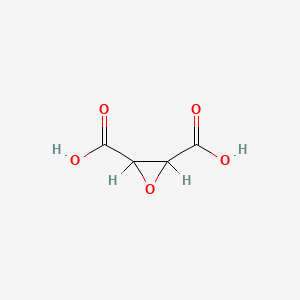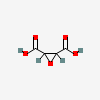2,3-Epoxysuccinic acid
- 2,3-Oxiranedicarboxylic acid
- oxirane-2,3-dicarboxylic acid
- 3272-11-5
- Epoxysuccinic acid
- 2,3-Epoxysuccinic acid
- Create:2005-03-26
- Modify:2025-01-18

40618-18-6 (di-hydrochloride salt)
6311-64-4 (di-potassium salt)
- 2,3-epoxysuccinic acid
- 2,3-epoxysuccinic acid, (trans(+))-isomer
- 2,3-epoxysuccinic acid, (trans(+-))-isomer
- 2,3-epoxysuccinic acid, (trans(-))-isomer
- 2,3-epoxysuccinic acid, (trans)-isomer
- 2,3-epoxysuccinic acid, barium (1:1) salt
- 2,3-epoxysuccinic acid, dipotassium salt
- 2,3-epoxysuccinic acid, disodium salt
- 2,3-epoxysuccinic acid, monopotassium salt
- L-trans-2,3-epoxysuccinic acid
- 2,3-Oxiranedicarboxylic acid
- oxirane-2,3-dicarboxylic acid
- 3272-11-5
- Epoxysuccinic acid
- 2,3-Epoxysuccinic acid
- cis-2,3-Epoxysuccinic acid
- DTXSID50901492
- EINECS 221-900-1
- NSC 243799
- 6311-64-4
- (2R,3R)-(-)-EPOXYSUCCINIC ACID
- NSC43234
- CCRIS 3757
- Epoxy-succinic acid
- 2,3-Oxiranedicarboxylic acid, cis-
- EINECS 240-604-3
- SCHEMBL253521
- 2,a3-aOxiranedicarboxylic acid
- CHEMBL2008310
- L-trans-2,3-epoxysuccinic acid
- DTXCID60197824
- NSC243799
- AKOS022504512
- NSC-243799
- AS-59308
- NCI60_004002
- trans-(+/-)-2,3-oxiranedicarboxylic acid
- NS00044201
- D94020


H302 (100%): Harmful if swallowed [Warning Acute toxicity, oral]
H315 (100%): Causes skin irritation [Warning Skin corrosion/irritation]
H318 (100%): Causes serious eye damage [Danger Serious eye damage/eye irritation]
H335 (100%): May cause respiratory irritation [Warning Specific target organ toxicity, single exposure; Respiratory tract irritation]
P261, P264, P264+P265, P270, P271, P280, P301+P317, P302+P352, P304+P340, P305+P354+P338, P317, P319, P321, P330, P332+P317, P362+P364, P403+P233, P405, and P501
(The corresponding statement to each P-code can be found at the GHS Classification page.)
Aggregated GHS information provided per 38 reports by companies from 1 notifications to the ECHA C&L Inventory. Each notification may be associated with multiple companies.
Information may vary between notifications depending on impurities, additives, and other factors. The percentage value in parenthesis indicates the notified classification ratio from companies that provide hazard codes. Only hazard codes with percentage values above 10% are shown.
Acute Tox. 4 (100%)
Skin Irrit. 2 (100%)
Eye Dam. 1 (100%)
STOT SE 3 (100%)
Patents are available for this chemical structure:
https://patentscope.wipo.int/search/en/result.jsf?inchikey=DCEMCPAKSGRHCN-UHFFFAOYSA-N
- CAS Common ChemistryLICENSEThe data from CAS Common Chemistry is provided under a CC-BY-NC 4.0 license, unless otherwise stated.https://creativecommons.org/licenses/by-nc/4.0/Epoxysuccinic acidhttps://commonchemistry.cas.org/detail?cas_rn=3272-11-5Polyepoxysuccinic acidhttps://commonchemistry.cas.org/detail?cas_rn=51274-37-4
- ChemIDplus2,3-Epoxysuccinic acidhttps://pubchem.ncbi.nlm.nih.gov/substance/?source=chemidplus&sourceid=0003272115cis-Epoxysuccinic acidhttps://pubchem.ncbi.nlm.nih.gov/substance/?source=chemidplus&sourceid=0016533725ChemIDplus Chemical Information Classificationhttps://pubchem.ncbi.nlm.nih.gov/source/ChemIDplus
- DTP/NCILICENSEUnless otherwise indicated, all text within NCI products is free of copyright and may be reused without our permission. Credit the National Cancer Institute as the source.https://www.cancer.gov/policies/copyright-reuse2,3-Oxiranedicarboxylic acidhttps://dtp.cancer.gov/dtpstandard/servlet/dwindex?searchtype=NSC&outputformat=html&searchlist=243799
- EPA DSSTox2,3-Oxiranedicarboxylic acidhttps://comptox.epa.gov/dashboard/DTXSID50901492CompTox Chemicals Dashboard Chemical Listshttps://comptox.epa.gov/dashboard/chemical-lists/
- European Chemicals Agency (ECHA)LICENSEUse of the information, documents and data from the ECHA website is subject to the terms and conditions of this Legal Notice, and subject to other binding limitations provided for under applicable law, the information, documents and data made available on the ECHA website may be reproduced, distributed and/or used, totally or in part, for non-commercial purposes provided that ECHA is acknowledged as the source: "Source: European Chemicals Agency, http://echa.europa.eu/". Such acknowledgement must be included in each copy of the material. ECHA permits and encourages organisations and individuals to create links to the ECHA website under the following cumulative conditions: Links can only be made to webpages that provide a link to the Legal Notice page.https://echa.europa.eu/web/guest/legal-noticeEpoxysuccinic acidhttps://echa.europa.eu/substance-information/-/substanceinfo/100.019.910Dipotassium epoxysuccinatehttps://echa.europa.eu/substance-information/-/substanceinfo/100.026.033Epoxysuccinic acid (EC: 221-900-1)https://echa.europa.eu/information-on-chemicals/cl-inventory-database/-/discli/details/135654
- ChEMBLLICENSEAccess to the web interface of ChEMBL is made under the EBI's Terms of Use (http://www.ebi.ac.uk/Information/termsofuse.html). The ChEMBL data is made available on a Creative Commons Attribution-Share Alike 3.0 Unported License (http://creativecommons.org/licenses/by-sa/3.0/).http://www.ebi.ac.uk/Information/termsofuse.html
- Japan Chemical Substance Dictionary (Nikkaji)
- KNApSAcK Species-Metabolite Database
- LOTUS - the natural products occurrence databaseLICENSEThe code for LOTUS is released under the GNU General Public License v3.0.https://lotus.nprod.net/2,3-Oxiranedicarboxylic acidhttps://www.wikidata.org/wiki/Q110076540LOTUS Treehttps://lotus.naturalproducts.net/
- Springer Nature
- Thieme ChemistryLICENSEThe Thieme Chemistry contribution within PubChem is provided under a CC-BY-NC-ND 4.0 license, unless otherwise stated.https://creativecommons.org/licenses/by-nc-nd/4.0/
- Wikidatatrans-2,3-epoxysuccinic acidhttps://www.wikidata.org/wiki/Q110076540
- PubChem
- Medical Subject Headings (MeSH)LICENSEWorks produced by the U.S. government are not subject to copyright protection in the United States. Any such works found on National Library of Medicine (NLM) Web sites may be freely used or reproduced without permission in the U.S.https://www.nlm.nih.gov/copyright.html2,3-epoxysuccinic acidhttps://www.ncbi.nlm.nih.gov/mesh/67017290
- GHS Classification (UNECE)GHS Classification Treehttp://www.unece.org/trans/danger/publi/ghs/ghs_welcome_e.html
- NORMAN Suspect List ExchangeLICENSEData: CC-BY 4.0; Code (hosted by ECI, LCSB): Artistic-2.0https://creativecommons.org/licenses/by/4.0/NORMAN Suspect List Exchange Classificationhttps://www.norman-network.com/nds/SLE/
- MolGenieMolGenie Organic Chemistry Ontologyhttps://github.com/MolGenie/ontology/
- PATENTSCOPE (WIPO)SID 403420349https://pubchem.ncbi.nlm.nih.gov/substance/403420349

